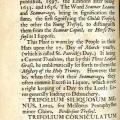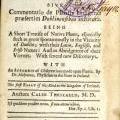The Shamrock – An Seamróg: Ireland’s national symbol
Published on 14th March 2014
 This weekend many people around the world will be wearing the Shamrock, a tiny plant symbolising the Irish nation. Taoiseach Enda Kenny will present a bowl of Shamrock to the President of the United States, Barack Obama, today. One of the earliest published accounts, Caleb Threlkeld’s treatise on native Irish plants, Synopsis Stirpium Hibernicarum, published in 1726, refers to our national symbol the Shamrock under its botanical name Trifolium Pratense, (White flowered meadow trefoil). There has been much debate about the exact origin of the Shamrock, many people considering it a form of clover. See Charles Nelson's book on the subject. Threlkeld notes its identification by Gerard in his Herbal of 1597. He gives its Irish name Seamar-oge, and refers to people wearing it in their hats on 17th March, St Patrick’s Day. As a clergyman, Rev. Dr. Threlkeld shows his disapproval of the way the people celebrated the day by "wetting the Shamrock".
This weekend many people around the world will be wearing the Shamrock, a tiny plant symbolising the Irish nation. Taoiseach Enda Kenny will present a bowl of Shamrock to the President of the United States, Barack Obama, today. One of the earliest published accounts, Caleb Threlkeld’s treatise on native Irish plants, Synopsis Stirpium Hibernicarum, published in 1726, refers to our national symbol the Shamrock under its botanical name Trifolium Pratense, (White flowered meadow trefoil). There has been much debate about the exact origin of the Shamrock, many people considering it a form of clover. See Charles Nelson's book on the subject. Threlkeld notes its identification by Gerard in his Herbal of 1597. He gives its Irish name Seamar-oge, and refers to people wearing it in their hats on 17th March, St Patrick’s Day. As a clergyman, Rev. Dr. Threlkeld shows his disapproval of the way the people celebrated the day by "wetting the Shamrock".
 Synopsis Stirpium Hibernicarum: or a short treatise of native plants by Caleb Threlkeld (1676-1728) was published in Dublin in 1726 and reissued the following year with a new title page. He considered it the first Irish flora, calling it "the first essay of this kind in the Kingdom of Ireland". It includes the names of Irish native plants in English, Latin and Irish, giving their medicinal uses and any other interesting information. There is an introduction by Dr Thomas Molyneux, Physician to the State in Ireland, and an appendix that includes plants identified by Molyneux. This volume was published by subscription, which means that interested readers paid a part of the cost in advance of publication. A subscription list allows us to view the audience for a publication, in this case a lot of interest was shown in Galway, of the 99 names on the list 41 are from Galway. A facsimile edition was published in 1988 with a good introduction by E. Charles Nelson, which includes biographical information on Threlkeld.
Synopsis Stirpium Hibernicarum: or a short treatise of native plants by Caleb Threlkeld (1676-1728) was published in Dublin in 1726 and reissued the following year with a new title page. He considered it the first Irish flora, calling it "the first essay of this kind in the Kingdom of Ireland". It includes the names of Irish native plants in English, Latin and Irish, giving their medicinal uses and any other interesting information. There is an introduction by Dr Thomas Molyneux, Physician to the State in Ireland, and an appendix that includes plants identified by Molyneux. This volume was published by subscription, which means that interested readers paid a part of the cost in advance of publication. A subscription list allows us to view the audience for a publication, in this case a lot of interest was shown in Galway, of the 99 names on the list 41 are from Galway. A facsimile edition was published in 1988 with a good introduction by E. Charles Nelson, which includes biographical information on Threlkeld.